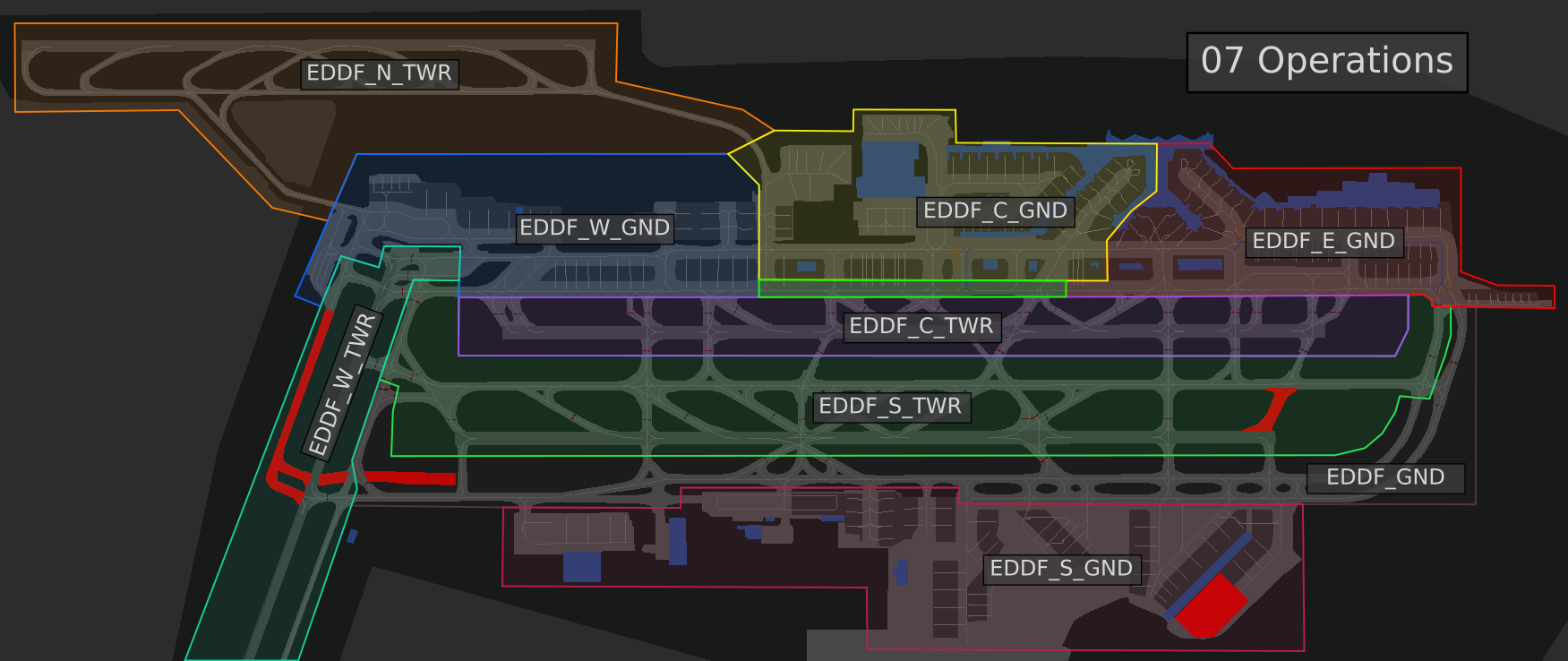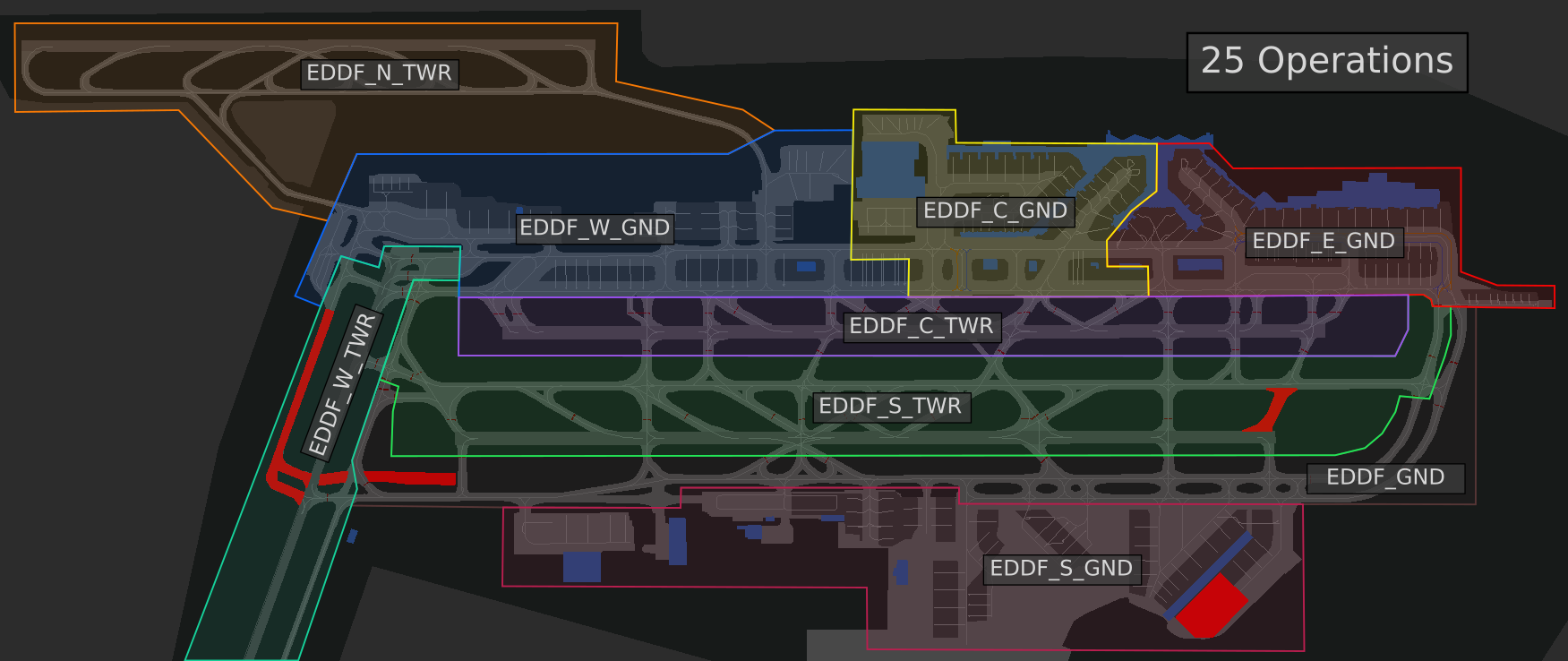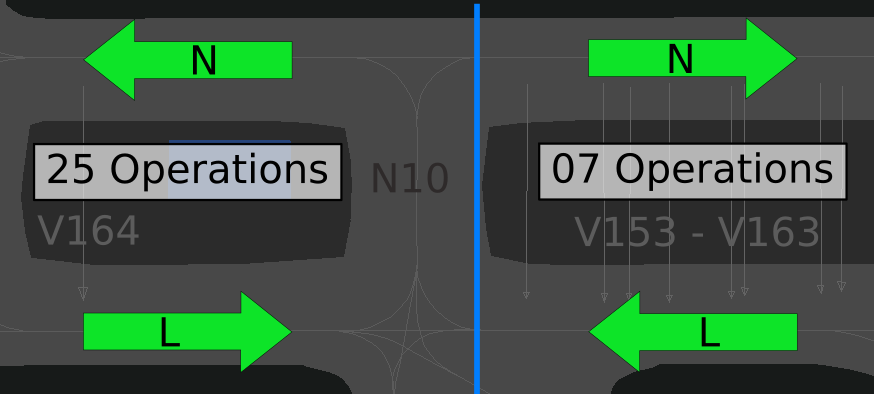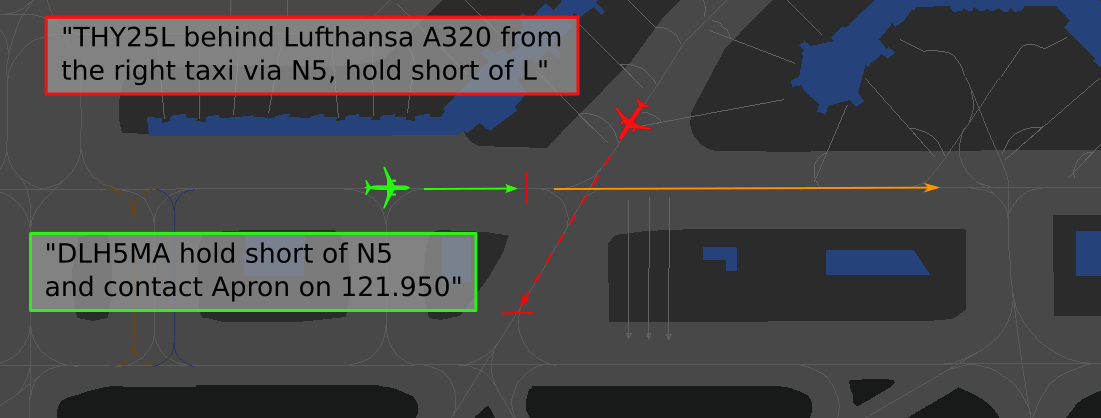Apron
Frankfurt Apron can be split into 4 stations as shown in the table and images below.
If more than one of these stations is staffed, Delivery needs to be staffed first. If just one Apron is online, this Apron takes over all other Apron stations, but not Frankfurt Ground.
| Station |
Station ID |
Login |
Frequency |
Remark |
| Center Apron |
DFGC |
EDDF_C_GND |
121.855 |
primary |
| East Apron |
DFGE |
EDDF_E_GND |
121.955 |
secondary |
| West Apron |
DFGW |
EDDF_W_GND |
121.755 |
will be taken over be DFGC if not staffed |
| South Apron |
DFGS |
EDDF_S_GND |
121.655 |
will be taken over by DFGE if not staffed not yet operational in the real world |
| Deicing |
DFGI |
EDDF_ICE_GND |
121.985 |
deicing operations only |
| Ground |
DFG |
EDDF_GND |
121.805 |
will be taken over bei DFTS if not staffed |
General Procedures
Taxiway Usage
Taxiway L is always used in the direction towards the holding point of the center runway, depending on runway in use. Taxiway N is used the other way (see image). During 07 operations taxiway N west of N11 is also used towards the west, which shall be used for runway 18 outbounds (L, N14, N).
Taxiway Restrictions
For B747, A380, A346 and B77W can be found here. The auto gate assignment will take care of that, so if a stand is auto assigned, the aircraft is allowed to taxi on the taxiway to get there.
Taxiway Links
Links connect taxiways N7 and N8 at different locations to enable the best traffic flow. If N7 and N8 are used within the same instruction, Links 3, 4 or 5 shall be used whenever applicable. These Links should be used with care because some pilots might not find/know them (Links are difficult to find as there are no signs, just visible at the charts). More images are available here.
Link 1 does not exist in real life anymore, and can not be found on any charts! Link 3 or N8 - N - N7 should be used instead.
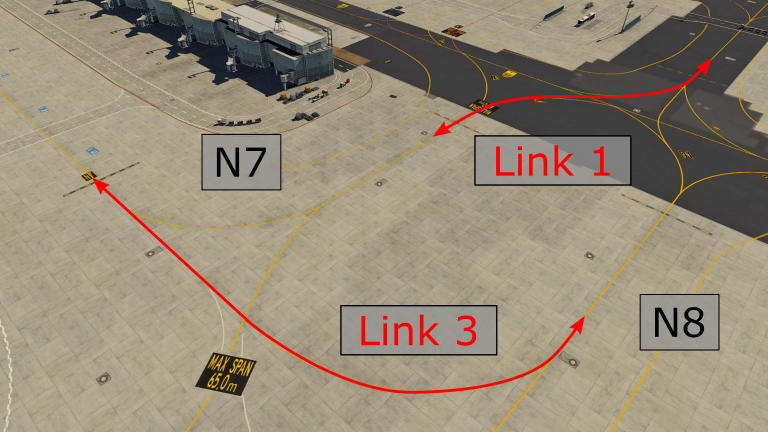 Usage of Link 1 and Link 3 between N7 and N8
Usage of Link 1 and Link 3 between N7 and N8
Colored Lines
Colored lines (orange and blue) can be used by all aircraft up to code C aircraft (A321/B739). Preplanning is required to use them the most efficient way.
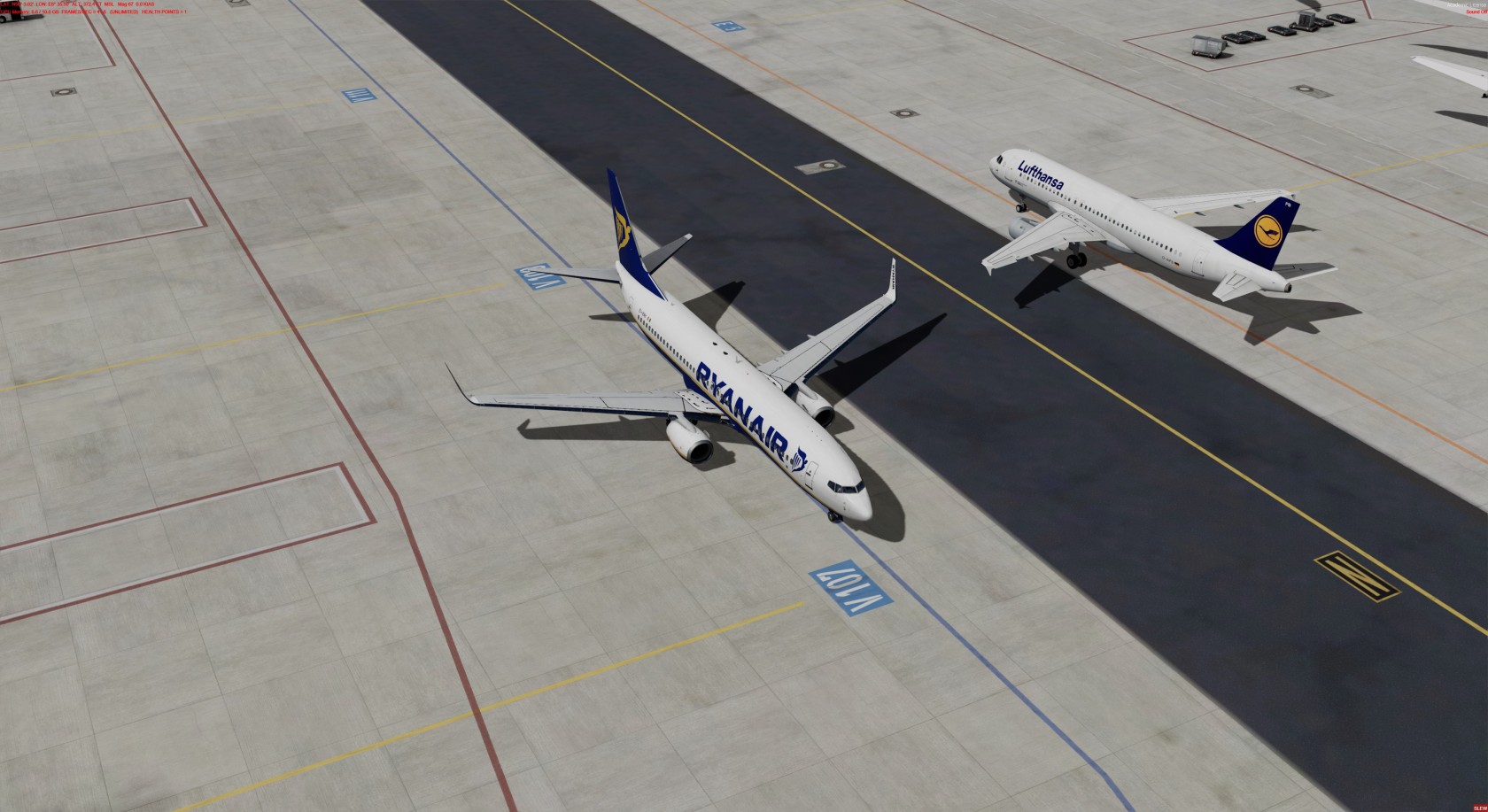 N-Blue and N-Orange used at the same time for parallel taxi
N-Blue and N-Orange used at the same time for parallel taxi
Pushback
V134 - V178 (all facing south), as well as positions C2, B10 and A1 are taxi out positions. V143 and V144 are pushback positions!
Straight pushbacks
Pushback from positions V108 - V118 (even numbers) always have to be done straight back. Straight pushback out of V106 will end behind position V108 facing north, when a GSX profile is used. Otherwise the intersection L/N-East - T is blocked.
DLH123, pushback approved, straight back, no turn.
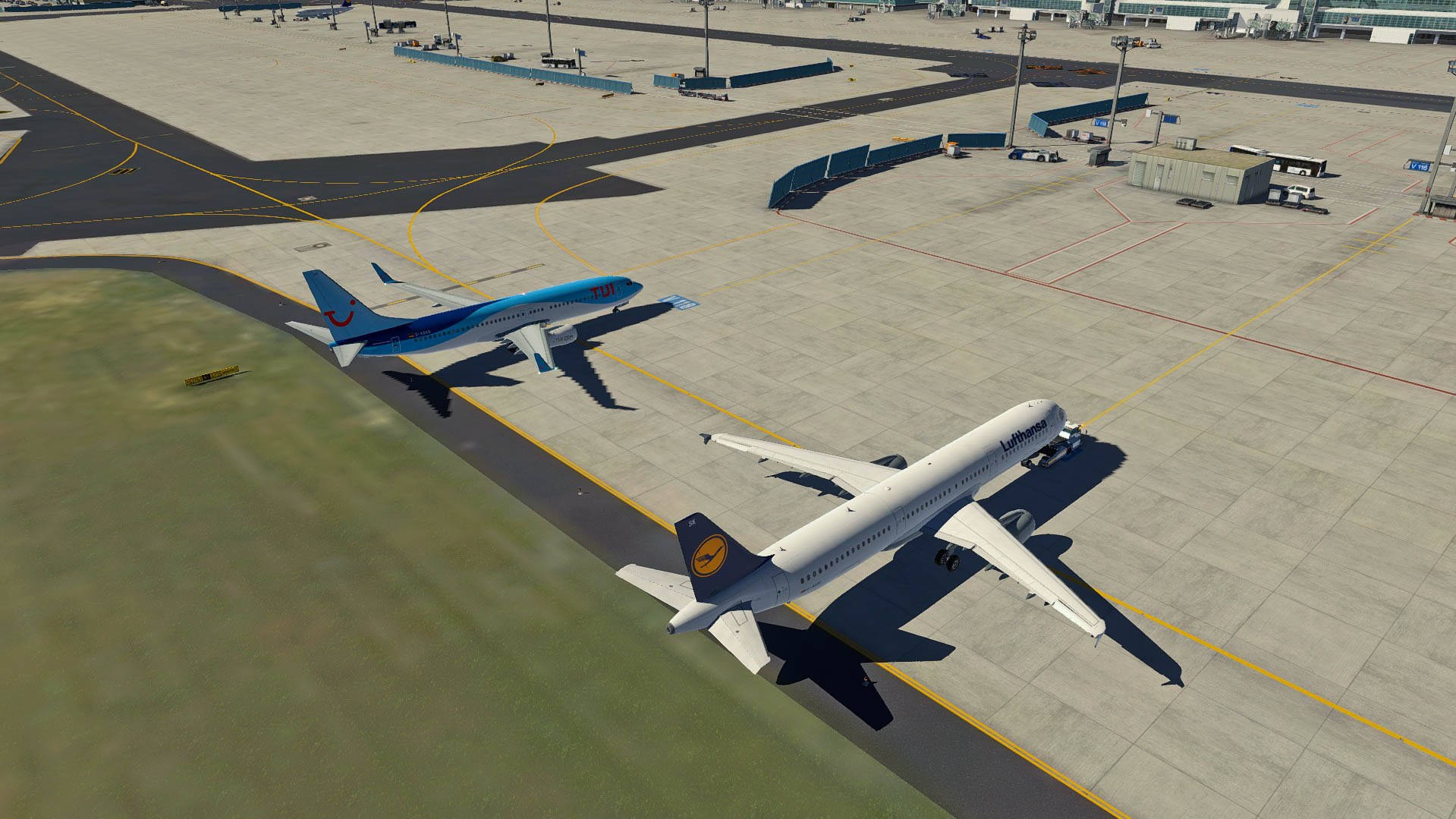 Straight pushback at positions V108 - V118 without turn
Straight pushback at positions V108 - V118 without turn
Straight pushback is also possible from positions V266 - V270 instead of using pushback areas 1 and 2.
In the real world, a straight pushback from V270 will result make a slight curve to end up behind stand V269 facing North. Some GSX profiles may simulate this, so controllers should consider V269 blocked until the straight pushback from V270 has concluded.
Pushback Areas
Various areas of Frankfurt's apron utilize predefined pushback areas to which pilots can be instructed to push. Depending on the combination of the stand and the pushback area, a push and pull maneuver may be required which not all pilots are able to comply with; if in doubt, controllers should ask the pilot if they are able to conduct a push and pull maneuver. Additionally, some GSX profiles now only offer presets for these areas at appropriate parking positions so pilots may explicitly request an area if they are given a normal pushback; this should be accommodated when possible, but GSX also allows pilots to manually edit their pushback route, so when a normal pushback makes more sense, the pushback to an area can also be denied.
These areas are always only available for the applicable yellow taxiline; when instructing an aircraft to push onto a colored line, areas may not be used.
As charts don't inform pilots of the possible directions for each area, the direction shall always be given with the clearance when instructing a pilot to push to an area.
| Taxiway |
Area |
Nose gear abeam stand |
Facing |
Restriction |
| N |
2 |
E5 / V111 |
West/East |
|
| N-East |
1 |
nose gear abeam service road between V106 and V107 |
North |
|
| N3 |
1 |
C6 / B44 |
South |
max. Code C |
| 2 |
C11 / B45 |
South |
max. Code E |
|
| N5 |
1 |
A15 / B22 |
South |
max. Code C |
| 2 |
B25 / A21 |
South |
max. Code E |
|
| 3 |
B26 / A25 |
South |
||
| N7/N8 |
1 |
A16 |
West |
max. Code C |
| 2 |
A24 |
South-West |
max. Code E |
|
| 3 |
A58A |
West |
||
| 4 |
A30 |
West |
max. Code C |
|
| 5 |
A58B |
East |
max. Code E |
|
| 6 |
A40 |
West |
max. Code E |
|
| 7 |
A66B |
West |
||
|
9 (should not be used) |
short of N |
South |
||
| P1 |
1 |
F238 |
West/East |
|
| 2 |
V267 |
West |
||
| S4 |
1 |
G6 |
North |
|
| 2 |
G12 |
North |
||
| S5 |
1 |
H4 |
North | max. Code C |
| 3 |
G13 |
North |
||
| S7 |
2 |
H12 |
North |
|
| S11/S15 |
6 |
V326 |
North |
|
| 7 |
short of S |
North |
||
| 1 |
K4 |
West |
max. Code C |
|
| 2 |
K10 |
West |
||
| 4 |
short of S11 |
West | ||
| L |
1 |
V94 |
West |
max. Code C |
| 2 |
V97 |
West |
max. Code C |
Other restrictions
Pushbacks from position F231 are only possible facing East.
Pushbacks from positions B23, B28, B42 and B48 have to finish the pushback on taxiway N (or in N4). While the pushback is still in progress, the intersection N - N4 can not be used!
Gate Assignment
Gates will be assigned by Ground Radar Plugin according to the real world. A-Stands are mainly used for DLH, AUA, TAP, AEE, SWR and UAL (Schengen and Non-Schengen area). Gates A50 to Gates A69 are DLH only. B and C-Stands are used for Star Alliance flights outside the Schengen area. Terminal 2 is mostly used for non-Star Alliance members and low cost operators, that are also located at the V-Positions in front of Terminal 2.
The first apron controller the inbound traffic contacts will always tell them their gate, even if it's under another Apron's responsibility.
Frankfurt Apron (West): DLH1255, gate A25, taxi via N11, L hold short of N8.
Frankfurt Apron (West): DLH1255, contact Apron on 121.855.
Inbounds 25C/07C
Inbound traffic to runway 25C/07C will be handed over from Tower with a hold short of L. This traffic is still blocking the runway after vacating and has to be treated with number one priority.
Handoff
Handoff to the next Apron controller will always take place with a hold short instruction of the next intersection close to the border of the area of responsibility (e.g. traffic from Center to West at N with a hold short of N10). Do not label any hold short for the transfer that is defined by the SOP!
Traffic Flow
If you have any “potential conflict” that will just generate waiting time for the pilot, please try to solve the problem without assigning a new gate. That will improve your preplanning skills a lot. Always try to work with conditional information as precisely as possible, but do not overload the pilot with useless information!
Frankfurt Apron: DLH123 at L give way to opposite company A320.
Frankfurt Apron: DLH456 at N4 number two behind Singapore A350 from right.
Frankfurt Apron: DLH789 behind opposite British Airway A319 taxi to holding point runway 18 via N, hold short of N5.
Tricks
- keep the traffic flow dynamical and use conditional instructions as often as practicable. Resolve a hold short with a conditional instruction as soon as practicable.
- you may deviate from the default taxi flow (coordination might be required) to enable an efficient flow (e.g. via N3, N, N1 instead of L).
- you may have to adjust the routing to avoid conflicts and holdshorts
- you have to monitor taxiway M and the holding points to see what you can expect entering your sector within the next minutes
Use of Intersections
Runway 07C/25C: Apron will not clear outbound traffic into intersections for runway 25C/07C. All outbounds are instructed to hold short of the intersection and Tower will instruct them to join the intersection that might be the best for the departure sequence.
Frankfurt Apron: DLH123, taxi to runway 25C via N4 and L, hold short of L3.
Frankfurt Apron (Center): DLH505, taxi to runway 25C via N8 and L, hold short of N4.
Frankfurt Apron (Center): DLH505, contact Apron on 121.955.
Frankfurt Apron (East): DLH505, hallo, continue via L, hold short of L3.
Frankfurt Apron (East): DLH505, contact Tower on 118.780.
Frankfurt Apron: AAL71, taxi to runway 25C via N, N1, hold short of L.
Frankfurt Apron: BAW906U, taxi to runway 18 via orange line and N, hold short of N5.
It is important that every handoff takes place as early as possible and has to be free of conflicts. Every potential conflict needs to be solved prior to the handoff. As soon as the outbound traffic is in contact with Tower, it is released by Apron up to L1 and Tower has the possibility to use every further intersection available. Even if the pilot reported to Apron to be able for L6, Tower still can use L3 (or L1) intersection if there is no benefit for the outbound to use an intersection. In that situation with traffic on L under control of Tower, other outbound traffic e.g. joining L via N3 needs to be number 2 behind the traffic on L.
Intersections a pilot is able for should be noted in the remarks. Do not label any hold short for the transfer that is defined by the SOP!
Keep in mind that if you would like to solve a conflict it might be useful to let outbound traffic continue via L even if he would be able for L6.
Runway 18: Departures out of runway 18 will always be sent directly to the holding point via N/L. Handoff should take place early, so that Tower still has the chance to take outbounds via N-South. During 25 operations intersection L needs to be coordinated. During 07 Operations N is still preferred for all heavy aircraft (routing via L, N14, N).
During high traffic load (decision rests with apron control) All MEDIUM and LIGHT aircraft departing via runway 18 and parking east of taxiway N3 shall be asked if they are able for departure out of intersection S. If they are, they should taxi to hold short of U2. Frankfurt Tower is responsible for further taxi.
Frankfurt Apron: DLH123A, advise able to depart from runway 18 intersection S?
Runway Crossing
The taxiways used for crossing are based on the planned parking position and runway in use (see image below). These taxiways are mandatory and only if a pilot uses the wrong taxiway the Tower controller should deviate from that after coordination with Apron. It is also possible to coordinate a different crossing taxiway (M6, M10, M30, Y, T) or procedure between Tower and Apron for crossing.
LVO: During LVO inbound traffic landed on runway 25L/07R will not cross the center runway. All traffic needs to taxi via T or Y, depending on their planned stand.
Tower is not allowed to issue take-off clearances as long as the intersection is blocked by just crossed traffic. That’s why Tower will issue the initial taxi route after crossing to the Pilot. This depends on the runway in use and the intersection used (see images).
When traffic crossed the runway it shall be sent to the according apron control as soon as possible, so traffic does not need to stop.
Apron is responsible for separation in the Apron at all times. Tower can issue the crossing clearances without looking at potential conflicts. A lot of planning is required for that.
Inbound traffic entering the Apron without crossing the runway will be instructed according to the table below. Frankfurt Apron is always responsible for all GAT and movements at the southern apron!
| Entry | Stand | Hold short of |
| P | all except those via P1 | N11 |
| P1 | F231 - F238 and V266 - V270 | W |
| S4 - S23 | South Parking (S, V3xx, J, K, G) | S4 - S23, according to the stand |
Specialties during 07 Operations
Border at N5: Traffic from Center to East Apron needs to hold short of N5. As soon as the handoff is initiated, this traffic is released and will always be number one (green aircraft). Only hand off aircraft which you do not need to stay there (e.g. if you would like to have your outbound at N5 as number 1 - see image, THY25L).
Mixed Area: Taxiway L between N5 and N11 is used in mixed responsibility and owned by West and Center Apron. Inbound Traffic with parking position inside the area of Center Apron will get the handoff from East to Center Apron short of N5.
Outbound traffic from V151 - V178 is handed over from Delivery to West Apron.
Outbound traffic towards runway 07C and 18 will be handed over from East to West Apron also short of N5. Outbound traffic from Center to West Apron need to hold short of L and is released for further taxi on handoff by Center. After the handoff this traffic is always number one to turn on L if there is other inbound traffic under control of Center Apron. So West Apron do not need to take care of inbound traffic under control of Center.
De-Icing
At Frankfurt de-icing is done around 50% at the parking position and 50% remote on the deicing pads. For departures out of runway 18 and 07 DP1 and DP2 are primary used, while for departures out of runway 25 DP3 and DP4 are prefered if deicing on the position is not possible. Most of the pads have an east and west part, where simultanious de-icing is possible.
| DP | Location | max. Usage |
| DP1 | west of runway 18 |
Code F (A388/B748) |
| DP2C | west of runway 18 |
Code F (A388/B748) |
| DP2E / DP2W |
west of runway 18 |
Code C (B739/A321) |
| DP3E / DP3W |
N7 blue/orange - facing north (!) |
Code C (B739/A321) |
| DP4E / DP4W |
V159 and V161 |
max. 2 engined heavies |
| DP5 |
G16A |
not used |
Outbounds on the southern apron need to use one of the pads on the northern side if deicing on the position is not possible.
As soon as the aircraft is on the pad the pilot need to contact the "ice house" to coordinate the deicing process and further details (no Apron duty). After de-icing the outbound needs to contact Apron again for further taxi to the holdingpoint.
Frankfurt Apron: DLH123 continue to DP2 Center, hold abeam the eyeline and contact ice house.

